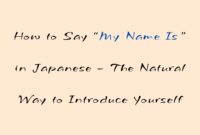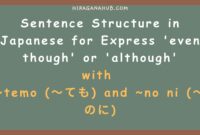Exploring Japanese Particles for Verbs: wo, ni, de, and e (を、に、で、へ)
After delving into subject particles like Wa, Mo, and Ga, let’s shift our
focus to particles that specifically assist verbs in Japanese: wo (を), ni
(に), de (で), and e (へ). These particles play crucial roles in sentence
construction and verb functionality.

Particle wo (を)
Written as “wo” but pronounced as “o,” this particle is essential for
indicating the direct object of a verb. For instance:
ピザを食べます – ぴざをたべます (Pizza wo tabemasu):
I eat pizza.
This particle is versatile, also applicable to motion verbs, like:
公園を走る – こうえんをはしる (Kouen wo hashiru):
Run through the park.
Particle ni (に)
Ni (に) is a multifunctional particle used for indicating location,
destination, recipient, and time, among others. For location:
図書館にいます – としょかんにいます (Toshokan ni
imasu): I am in the library.
For destination:
フランスに行きます – ふらんすにいきます (Furansu ni
ikimasu): I am going to France.
And for time:
7時に起きます – しちじにおきます (Shichiji ni
okimasu): I wake up at 7 o’clock.
Particle de (で)
De (で) often translates to “at” or “in” when indicating the location of an
action, similar to “ni,” but with a focus on the action rather than the state
of being. For example:
図書館で勉強します –
としょかんでべんきょうします (Toshokan de benkyou shimasu): I study
at the library.
It can also mean “by means of,” such as:
バスで学校に行きます –
ばすでがっこうにいきます (Basu de gakkou ni ikimasu): I go to school
by bus.
Particle e (へ)
E (へ), pronounced as “e,” points towards a direction or destination. It’s
subtler than “ni,” indicating a direction rather than a definite endpoint. For
example:
海へ泳ぎに行きます – うみへおよぎにいきます (Umi e
oyogi ni ikimasu): I am going swimming towards the sea.
It also appears in contexts addressing someone or something, often seen in
letters or greetings:
友達への手紙 – ともだちへのてがみ (Tomodachi e no
tegami): A letter to a friend.
Example Sentences Format:
図書館にいます – としょかんにいます (Toshokan ni
imasu): I am in the library.
Vocabulary List:
| Kanji | Hiragana | Romaji | English |
|---|---|---|---|
| ピザ | ぴざ | piza | pizza |
| 食べる | たべる | taberu | eat |
| 公園 | こうえん | kouen | park |
| 走る | はしる | hashiru | run |
| 図書館 | としょかん | toshokan | library |
| 勉強する | べんきょうする | benkyou suru | study |
| バス | ばす | basu | bus |
| 学校 | がっこう | gakkou | school |
| 海 | うみ | umi | sea |
| 泳ぐ | およぐ | oyogu | swim |
This overview provides a fundamental understanding of how to use the Japanese
particles wo, ni, de, and e in conjunction with verbs. Mastering their usage
will enhance your ability to form more complex sentences and express a broader
range of ideas in Japanese. Keep practicing, and don’t hesitate to ask
questions to further your understanding. See you in the next lesson!


